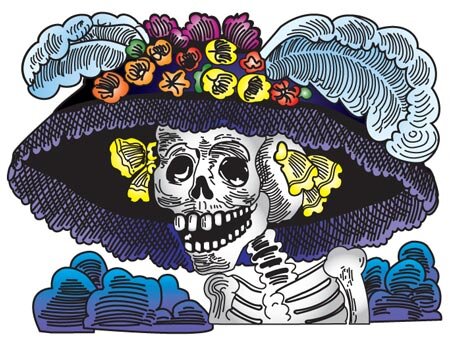La Calavera Catrina
Noble, stately and proud, La Calavera Catrina – or the "Skeleton of the Female Dandy" - has been an icon of Mexican Pop Art since the days before the Mexican Revolution. Often associated with the Mexican holiday, Día de los Muertos (Day of the Dead, November 2nd), the true history of La Catrina is one of politics and revolution.
Born as a series of witty lithographs and reliefs published in Mexico City, La Catrina was a satirical depiction of the life of the upper class during the reign of Porfirio Díaz. Her creator, Jose Guadalupe Posada (1852 – 1913), began his career early as an apprentice learning lithography and engraving, and while he was still in his teens, he began to illustrate political cartoons for the radical newspaper El Jicote (The Wasp). It was when an ex-politician, who made frequent cameo appearances in Posada’s satirical column, returned to a seat of political power that Posada felt his first slap in the face by political oppression. Forced to flee his hometown, Posada eventually made his way to Mexico City.
Posada joined forces with Antonio Vanegas Arroyo, the leading publisher of popular literature in Mexico, and the two flourished. Posada refined his style to more of a narrative pictorial that could be understood even if, as for much of the lower class, the text could not; Vanegas Arroyo aimed at producing inexpensive literature for the masses. And, together, their “penny press” put politically influential information in the hands of the commoners in the late 1800s and early 1900s, the years just prior to and during the Mexican Revolution of 1910.
Gifted at interpreting the life and social attitudes of the Mexican people, Posada began to use Mexico’s traditional Day of the Dead celebration as his theme. He would stage scenes with skeletons in working class barrios, in suburban communities and in the houses of the elite class. Riding on bicycles and garbed in the latest finery, Posada’s skeletons became metaphors for the corrupt elitist class, and La Catrina came to life. The word catrina is the feminine form of the word catrín, which means "dandy," or one who strives to imitate an aristocratic lifestyle even though many come from middle-class backgrounds.
While he was alive, Posada received what amounted to just a few cents for each of his drawings. He lived a humble life and upon his death, was buried in a common grave. His artwork is now a beloved symbol of Mexico itself, his name can be found in Mexican history books, and many artists, including Diego Rivera, Frenchman Jean Charlot, and José Clemente Orozco, have made tribute to him. Famed Mexican-American author during the revolutionary years of Mexico, Anita Brenner said that Posada “had sketched - in two inches - monumental figures and national epics, that later grew to ten and fifteen feet high on frescoed walls." La Calavera Catrina, a skull adorned with flowers, feathers, and bows, is a criticism of vanity as well as a reminder that all eventually turns to dust.

